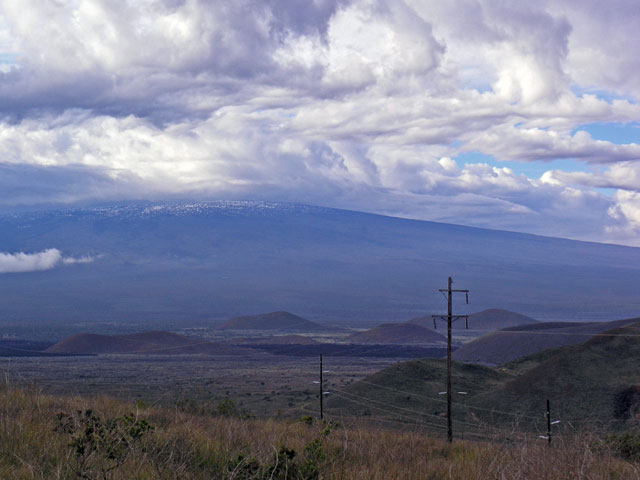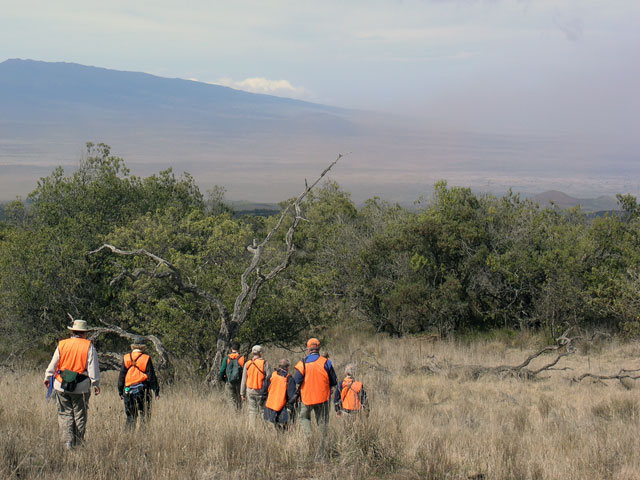
Mauna Loa showing snow at the peak.

The Hawaii Forest & Trail tour today was a birding expedition (Bird Watching Tour: Rainforest and Dryforest Birding Adventure) split between the dry forest on Mauna Kea’s southwest leeward slopes and the rainforest on Mauna Loa’s northwest, windward slope.
Very soon after being picked up by John, a transplanted Oklahoman, in the Hawaiʻi Forest and Trail bus, it became apparent that every other member of the party was a serious birder. Indeed the three folks who joined the party at the Keʻohe Game Management Area were birders also. One of them, and elderly Brit named Chris with a cannon for a Canon of a lens was at an even higher level. Jonathan described us as second-hand birders – we’ll gladly peer through binoculars, cameras, and other optical devices at the eagerly sought avian specimens, but beyond that we’re more interested in the local flora.
So while the birders happily chattered about their shared interests, Jonathan and I simply listened in.
The dry forest is dominated by two trees – naio with tiny white flowers, and māmane, a legume with yellow flowers. The primary target of this morning’s adventure was the palila and endemic but endangered species. In this area we saw a lot of amakihi, but locating the yellow headed palila took some time, but we were ultimately successful in finding one of the thousand or so remaining individuals.
We reboarded the bus (with the three folks based in Hilo following us in their rental cars) and drove eastward through a dust storm that blew up while we were searching for the elusive palila.

A dust storm blew up while we chasing birds. The blaze orange vests were necessary as it was hunting season.
The trail head of the Puʻu Oʻo Trail in the Upper Waiakea Forest Preserve (not the Puʻu Oʻo producing the lava we saw at the Volcanoes National Park) is located in the middle of a lava flow just off the Saddle Road at ~6,000 ft elevation. The trail starts through a field of aʻa lava moving through older flows of the pahoehoe lava, with the path well marked by a series of cairns. At a point known only to hour guide John, he turned off the trail and into the rain forest.
As mentioned earlier by Eugene on the Twilight Volcano Tour, the rainforests on the island are upside-down. The primary trees in the forest, ōhiʻa lehua, have rather small leaves with allows significant light to reach the understory. So we ended up tramping after John and the rest of the birders through this kīpuka (an area with older vegetation surrounded by lava flows, an island of life). We spotted an number of species like the bright red iʻiwi, but the big quarry was the ʻakiapolaʻau, the “aki” for short.
John discussed the particular individuals he was familiar with (yes, bird individuals, I'm surprised he hadn't named them), specifically a mated pair and their two recent offspring of the same laying. He described how the larger nestling had been expelled from the nest by the parents who were still raising the smaller sibling. And by golly he found them in that forest to the great pleasure of the group.
[Note: I asked about a bird scope when I booked the tour thinking I could get a shot like the scarlet macaw photo that I took in Costa Rica. I was told that these species were too energetic and didn’t stay in one place too long so a scope was not a good tool.]
There were numerous other species spotted during the day including some pleasing sightings of the Hawaiʻian owl (pueo) and more exciting a pair of iʻo, the endangered Hawaiʻian hawk on the drive back.
List of native birds seen:
nēnē (goose)*,
iʻo (hawk)*,
pueo (owl),
ʻelepaio (flycatcher),
ʻōmaʻo (thrush),
palila*,
amakihi,
ʻakiapolaʻau*,
and iʻiwi.
The asterisk (*) indicates endangered.
Weatherwise, we’ve been fortunate (except for the snow on Mauna Kea) and it was generally dry and sunny throughout the rain forest. On the way back, we ran into fog and low clouds where the owl and hawk were seen, and then back into dry and partly cloudy skies.
John asked us if we’d like to stay on the bus while they turned the opposite way from our resort in search of the grey francolin, but we asked to be dropped off forthwith.
Rather than seeing external dining opportunities, we opted to eat in the hotel’s restaurant. Jonathan proclaimed he was having alcohol withdrawal, so we ordered a bottle of a nice New Zealand pinot noir with dinner.